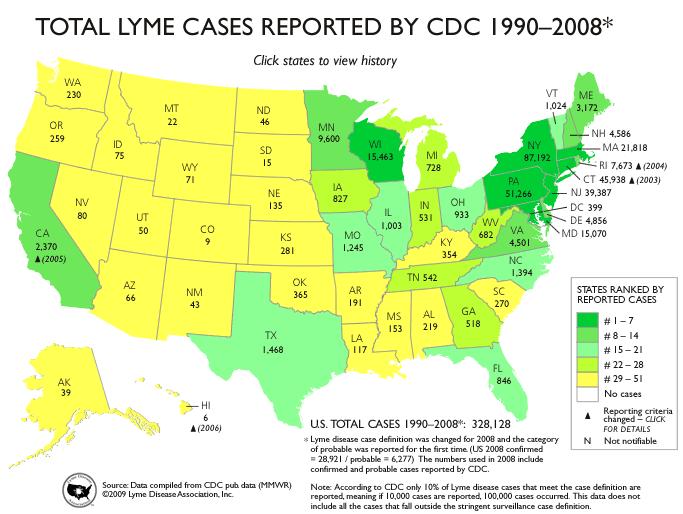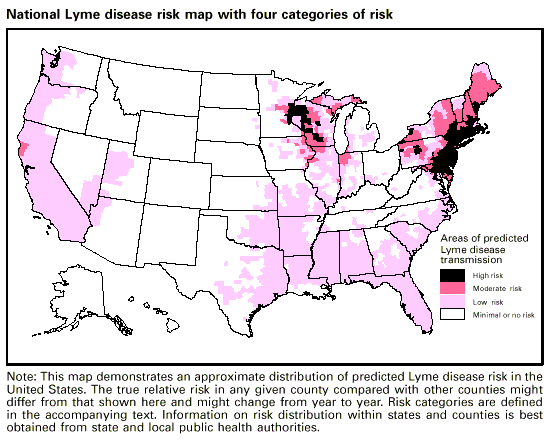Menstuff® has compiled information on the issue of Lyme's Disease

Lyme Disease Warnings Renewed As Pest
Population Appears to Rise
Medical journals call the creature lxodes scapularis, a bloodsucking animal that carries a bacterium that causes the flulike symptoms and rash of Lyme disease. Parents know it as a summer scourge, requiring daily tick checks on children.
Lyme disease was first identified in the mid-1970s after a group of children in Lyme, Conn., developed arthritis. Since then, researchers have found that the disease is most common in rural and suburban areas in the Northeast, where ticks hook onto deer, known to roam neighborhoods, parks and back yards.
Most researchers agree that, if caught early, Lyme disease can be treated successfully with up to six weeks of antibiotics. But there are some patients who discover the disease late or who receive treatment but later report chronic pain, severe fatigue and a host of neurological problems. Their hands shake. They suffer from facial paralysis.
For now, though, groups like National Capital Lyme Disease Association, based in McLean, say awareness of ticks is the most important protective step.
"Wear light-colored clothes and long shirts and pants," advised
Monte Skall, executive director of the group, who has Lyme disease.
"And the most important thing to do is a tick check. It's really
important this season."
Source: Emily Wax,
Washington Post,www.healthlinkusa.com/getpage.asp?http://www.washingtonpost.com/wp-dyn/articles/A29845-2023Jun22.html
![]()
Ways To Avoid Lyme Disease
Infection
New Approach Against Lyme
Disease
Very Early Lyme Disease Rash Is Red
Throughout, Not A Bull's-Eye
More data needed on Lyme vaccine safety
A majority of panelists said the data did not shed new light on concerns raised before approval.
Patricia Ferrieri, a panel consultant and former committee member from the University of Minnesota Medical School, noted an increase in side effect reports and testimony from a vocal group of people who received the vaccine, many of whom claimed they developed autoimmune arthritis from LYMErix.
Barbara Loe Fisher, the panel's consumer representative, urged the agency not to ignore these anecdotal reports. "We cannot continue to dismiss these as coincidental events," said Fisher, president of the National Vaccine Information Center.
Glaxo SmithKline has distributed 1.4 million doses of LYMErix, but it did not estimate how many people might have received the vaccine, delivered in three to five shots over a year.
The agency has received 1,048 reports of events potentially related to LYMErix, including 133 reports of arthritis or arthritic-type symptoms. Robert Ball of the FDA said that, so far, they do not provide clear evidence that LYMErix had caused the effects.
There were more reports in 2000 than in 1999. The uptick might be due to a late onset of symptoms, or news stories suggesting a link between the vaccine and arthritis, Ball said.
The agency is hoping to get to the bottom of the issue. It is interviewing people who reported symptoms and will compare them with other vaccine recipients in the FDA database.
A pregnancy registry for human vaccine recipients and reproductive toxicity trials in rats showed no unexpected events in mothers or fetuses, said Glaxo SmithKline. But panelists were not convinced; one noted a high rate of abortions.
Finally, the company reported initial results of a 5-year prospective study in people who routinely receive LYMErix at the Harvard Pilgrim Health Plan in Boston.
The study was to follow 25,000 vaccine recipients, but very few people are getting LYMErix. So far, only about 3,000 people are in the study.
Starting this year, the company is adding LYMErix vaccine recipients from Tufts Health Plan and HealthPartners health plan in Minnesota to boost study numbers.
Even so, the lack of enrollees worried panelists, who said the smaller numbers might make it harder to draw definitive conclusions and that it may take much longer to get results.
Steven Sheller, a Philadelphia attorney representing vaccine recipients who claim they got arthritis from LYMErix, called for a moratorium on LYMErix sales until more information was gathered. Consumer advocate Sidney Wolfe, director of Public Citizen Health Research Group, urged FDA to change LYMErix labeling to highlight potential problems.
Panelists agreed labeling should be strengthened for both patients and physicians.
Source: www.healthanswers.com/Centers/Topic/NewsStory.asp?newsid=10899&id=women's+health
![]()
Still No Effective Treatment For Post-Lyme
Disease Symptoms
Further investigation revealed that Lyme disease is caused by the
bacterium, Borrelia burgdorferi. These bacteria are transmitted to
humans by the bite of infected deer ticks and caused more than 23,000
infections in the United States in 2002.
|
From left to right: The deer tick (Ixodes scapularis) adult female, adult male, nymph, and larva on a centimeter scale. |
Vector: Black-legged ticks (Ixodes scapularis) are responsible for transmitting Lyme disease bacteria to humans in the northeastern and north-central United States. On the Pacific Coast, the bacteria are transmitted to humans by the western black-legged tick (Ixodes pacificus). Ixodes ticks are much smaller than common dog and cattle ticks. In their larval and nymphal stages, they are no bigger than a pinhead. Ticks feed by inserting their mouths into the skin of a host and slowly take in blood. Ixodes ticks are most likely to transmit infection after feeding for two or more days.
Risk: In the United States, Lyme disease is mostly localized to states in the northeastern, mid-Atlantic, and upper north-central regions, and to several counties in northwestern California. In 2002, 23,763 cases of Lyme disease were reported to the Centers for Disease Control and Prevention (CDC) (MMWR 52(31):741-750). Ninety-five percent of these cases were from the states of Connecticut, Delaware, Rhode Island, Maine, Maryland, Massachusetts, Minnesota, New Jersey, New Hampshire, New York, Pennsylvania, and Wisconsin. (See Map)
Individuals who live or work in residential areas surrounded by tick-infested woods or overgrown brush are at risk of getting Lyme disease. Persons who work or play in their yard, participate in recreational activities away from home such as hiking, camping, fishing and hunting, or engage in outdoor occupations, such as landscaping, brush clearing, forestry, and wildlife and parks management in endemic areas may also be at risk of getting Lyme disease.
Prevention and Treatment: Prevention measures can be effective in reducing your exposure to infected ticks, and most people can be successfully treated with antibiotic therapy when diagnosed in the early stages of Lyme disease.
Questions and Answers
Other Tick-Borne Diseases: Information about other tick transmitted illnesses like Southern tick-associated rash illness (STARI), Babesia infection, and ehrlichiosis can be found at CDC Health Topics A-Z.
More on the History of Lyme Disease: Early in the 20th century, European physicians observed patients with a red, slowly expanding rash (called erythema migrans or EM), associated this rash with the bite of ticks, and postulated that it was caused by a tick-borne bacterium. Then in the 1940s, similar tick-borne illness was described that often began with EM and developed into multi-system illness. Later that decade, spirochete-like structures were observed in skin specimens leading to the use of penicillin for treatment.
Aware of these findings, a physician in Wisconsin diagnosed a patient with EM and successfully treated it with penicillin in 1969. In the mid-1970s, physicians observed clusters of children with arthritis in and around Lyme, Connecticut. Other clinical symptoms and environmental conditions suggested that this was a distinct illness probably transmitted by an arthropod. Researchers linked the presence of EM rash lesions to preceding tick bites and determined that early treatment with penicillin not only shortened the duration of EM but also reduced the risk of subsequent arthritis.
In 1982, spirochetes were identified in the midgut of the adult deer tick, Ixodes dammini (referred herein by its original name, the black-legged tick, Ixodes scapularis) and given the name Borrelia burgdorferi. Finally, conclusive evidence that B. burgdorferi caused Lyme disease came in 1984 when spirochetes were cultured from the blood of patients with EM, from the rash lesion itself, and from the cerebrospinal fluid of a patient with meningoencephalitis and history of prior EM. CDC began surveillance for Lyme disease in 1982 and the Council of State and Territorial Epidemiologists (CSTE) designated Lyme disease as a nationally notifiable disease in January 1991.
References:
Barbour AG. Lyme Disease: The Cause, the Cure, the Controversy. 1996. The Johns Hopkins University Press, Baltimore, MD.
Benach JL, Bosler EM, Hanrahan JP, et al. Spirochetes isolated from the blood of two patients with Lyme disease. N Engl J Med. 1983;308:740-742.
Burgdorfer W. How the discovery of Borrelia burgdorferi came about. Clin Dermatol. 1993 Jul-Sep;11(3):335-338.
Burgdorfer WA, Barbour AG, Hayes SF, et al. Lyme disease - a tick-borne spirochetosis? Science. 1982;216:1317-1319.
Centers for Disease Control and Prevention. Notice to Readers: Final 2002 Reports of Notifiable Diseases. MMWR. 8 August 2003; 5(31):741-750.
Centers for Disease Control and Prevention. Appendix Methods Used for Creating a National Lyme Disease Risk Map. MMWR. 4 Jun 1999;48(RR07);21-24.
Centers for Disease Control and Prevention. Lyme Disease—United States, 1999. MMWR. 16 Mar 2001;50(10):181-185.
Hellerstrom S. Erythema chronicum migrans Afzelius with meningitis. Southern Med J. 1950;43:330-335.
Nadelman RB and Wormser GP. Lyme borreliosis. Lancet. 1998;352:557-565.
Orloski KA, Hayes EB, Campbell GL, Dennis DT. Surveillance for Lyme disease--United States, 1992-1998. Mor Mortal Wkly Rep CDC Surveill Summ. 2000 Apr 28;49(3):1-11.
Rahn DW, Evans J eds. Lyme Disease. 1998. American College of Physicians, Philadelphia, PA.
Scrimenti RJ. Erythema chronicum migrans. Arch Dermatol. 1970;102:104-105.
Sood SK, Salzman MB, Johnson BJ, Happ CM, Feig K, Carmody L, Rubin LG, Hilton E, Piesman J. Duration of tick attachment as a predictor of the risk of Lyme disease in an area in which Lyme disease is endemic. J Infect Dis. 1997 Apr;175(4):996-999.
Steere AC. Lyme disease. N Engl J Med. 1989 Aug 31;321(9):586-596.
Steere AC. Lyme disease. N Engl J Med. 2001 Jul 12;345(2):115-125.
Steere AC, Grodzicki RL, Kornblatt AN, et al. The spirochetal etiology of Lyme disease. N Engl J Med. 1983;308:733-740.
Steere AC, Malawista SE, Hardin JA, et al. Erythema chronicum migrans and Lyme arthritis: the enlarging clinical spectrum. Ann Intern Med. 1977;86:685-698.
Steere AC, Malawista SE, Newman JH, et al. Antibiotic therapy in Lyme disease. Ann Intern Med. 1980;93:1-8.
Steere AC, Malawista SE, Snydman DR, et al. Lyme arthritis: an epidemic of oligoarticular arthritis in children and adults in three Connecticut communities. Arthritis Rheum. 1977;20:7-17.
Wang G, van Dam AP, Schwartz I, Dankert J. Molecular typing of
Borrelia burgdorferi sensu lato: taxonomic, epidemiological, and
clinical implications.Clin Microbiol Rev. 1999 Oct;12(4):633-653.

* * *
|
|